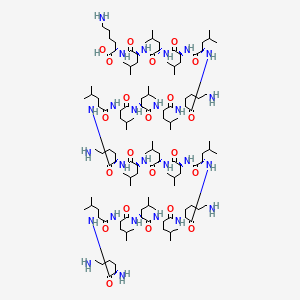



API Suppliers

US DMFs Filed

CEP/COS Certifications
0

JDMFs Filed
0
Other Certificates
0
Other Suppliers
0
0
0

USA (Orange Book)
0

Europe
0

Canada
0

Australia
0

South Africa
0
Uploaded Dossiers
0
U.S. Medicaid
0
Annual Reports
0
USFDA Orange Book Patents
0
USFDA Exclusivities
0
Blog #PharmaFlow
0
News
0
EDQM
0
USP
0
JP
0
Other Listed Suppliers
0
0


1. 138531-07-4
2. Ati 01
3. Kl4 (peptide)
4. Sinapultide [usan:inn]
5. Unii-040x3ax99t
6. Kl4 Peptide
7. Rwj 45652
8. Peptide Kl4
9. Peptide Kl-4
10. Schembl180504
11. Ati-01
12. Chembl2103901
13. Dtxsid30160707
14. 040x3ax99t
15. Rwj-45652
16. Db11332
17. L-lysine, L-lysyl-l-leucyl-l-leucyl-l-leucyl-l-leucyl-l-lysyl-l-leucyl-l-leucyl-l-leucyl-l-leucyl-l-lysyl-l-leucyl-l-leucyl-l-leucyl-l-leucyl-l-lysyl-l-leucyl-l-leucyl-l-leucyl-l-leucyl-
18. L-lysyl-l-leucyl-l-leucyl-l-leucyl-l-leucyl-l-lysyl-l-leucyl-l-leucyl-l-leucyl-l-leucyl-l-lysyl-l-leucyl-l-leucyl-l-leucyl-l-leucyl-l-lysyl-l-leucyl-l-leucyl-l-leucyl-l-leucyl-l-lysine
| Molecular Weight | 2469.4 g/mol |
|---|---|
| Molecular Formula | C126H238N26O22 |
| XLogP3 | 11.9 |
| Hydrogen Bond Donor Count | 27 |
| Hydrogen Bond Acceptor Count | 28 |
| Rotatable Bond Count | 93 |
| Exact Mass | 2468.83375816 g/mol |
| Monoisotopic Mass | 2467.83040333 g/mol |
| Topological Polar Surface Area | 775 Ų |
| Heavy Atom Count | 174 |
| Formal Charge | 0 |
| Complexity | 4880 |
| Isotope Atom Count | 0 |
| Defined Atom Stereocenter Count | 21 |
| Undefined Atom Stereocenter Count | 0 |
| Defined Bond Stereocenter Count | 0 |
| Undefined Bond Stereocenter Count | 0 |
| Covalently Bonded Unit Count | 1 |
Infant respiratory distress syndrome,,,.
Windtrees KL4 surfactant technology produces a synthetic surfactant that is structurally similar to human pulmonary surfactant and contains a proprietary synthetic peptide KL4 (sinapultide), cost a 21-amino acid peptide that is formulated to mimic the essential attributes of the human surfactant protein B (SP-B). This protein is one of four surfactant proteins and is the most important for the adequate function of the respiratory system. Windtree has demonstrated in pre-clinical studies that KL4 surfactant may possess certain other beneficial properties, including alteration of the inflammatory process, antimicrobial properties as well as non-immunogenicity.
Absorption
Administered directly to the lung, where biophysical effects occur at the terminal airways and alveolar surface. No human pharmacokinetic studies have been done to characterize the absorption, distribution, metabolism, or elimination of this drug.
Endogenous pulmonary surfactant lowers surface tension at the air-liquid interface of the alveolar surfaces during respiration and stabilizes the alveoli against collapse at resting transpulmonary pressures. A deficiency of pulmonary surfactant in premature infants results in RDS. Surfaxin, the drug in which this protein is included, compensates for the deficiency of surfactant and restores surface activity to the lungs of these infants. To explore the mechanisms of protection that this sinapultide offers against RDS, in vitro assays were performed with human and murine endothelial cell monolayers, and polymorphonuclear leukocyte (PMN) transmigration in the presence or absence of KL(4)-surfactant or lipid controls was studied. Based on morphology, histopathology, white blood cell count, percentage of PMNs, and protein concentration in bronchoalveolar lavage fluid, the results that showed KL(4)-surfactant, blocked neutrophil influx into alveoli and thus prevented lung injury. Additionally, in vitro assays demonstrated KL(4)-surfactant decreased neutrophil transmigration at the endothelial cell level. KL(4)-surfactant diminished inflammation and lung permeability when compared with controls in both mouse models of lung injury. Evidence suggests the anti-inflammatory mechanism of the KL(4)-peptide is achieved through inhibition of PMN transmigration through the endothelium.


